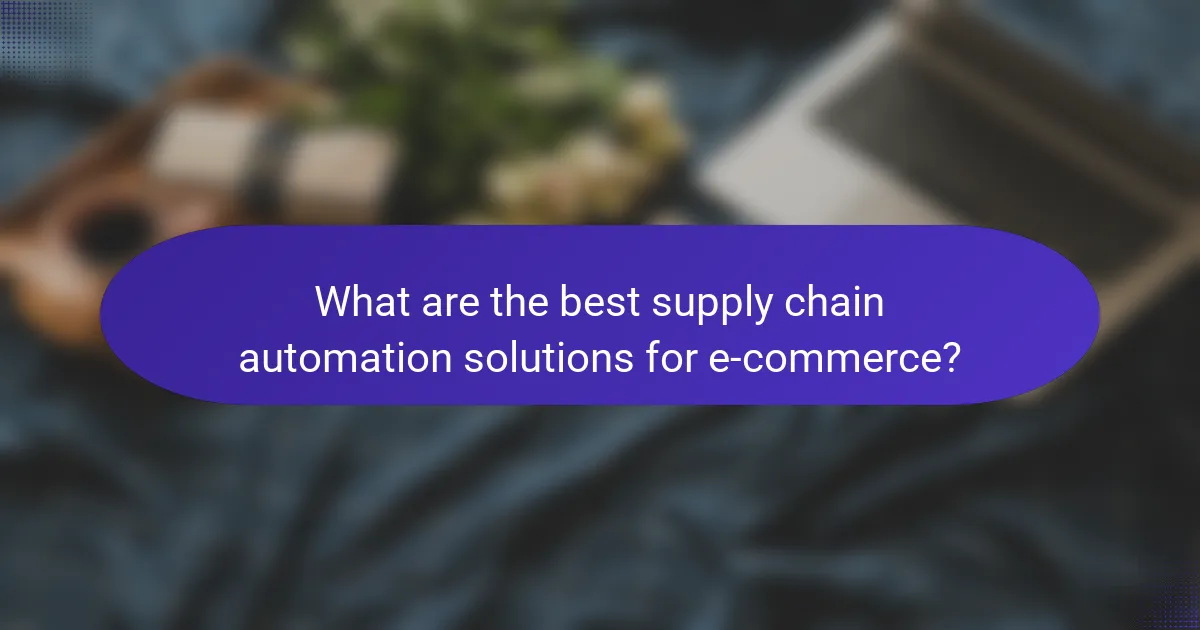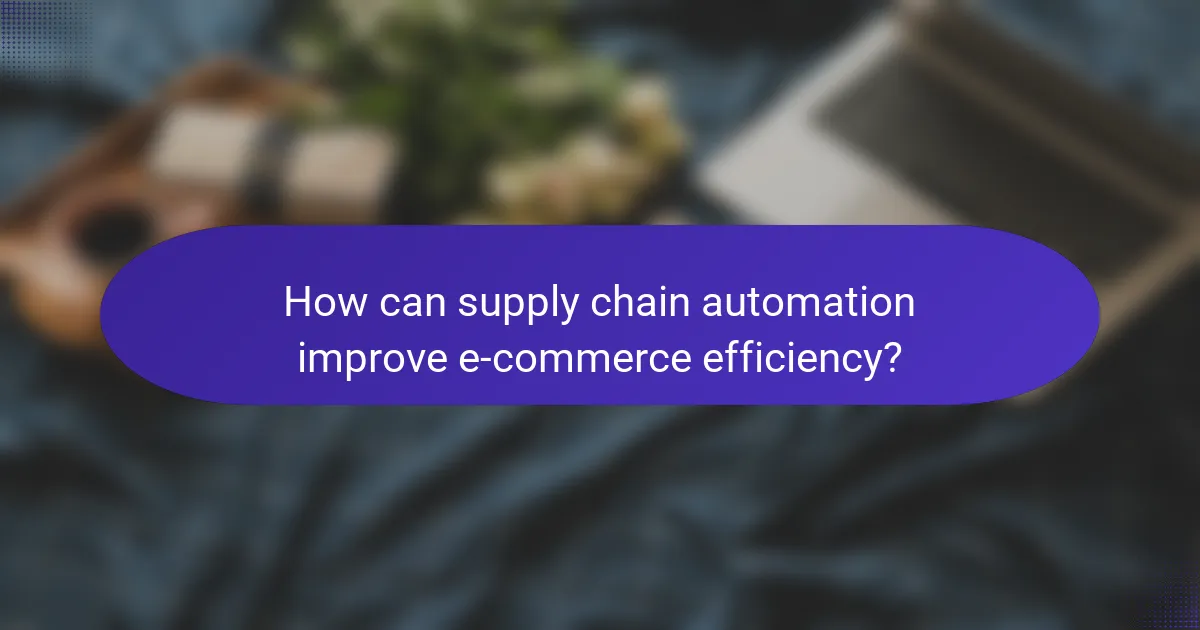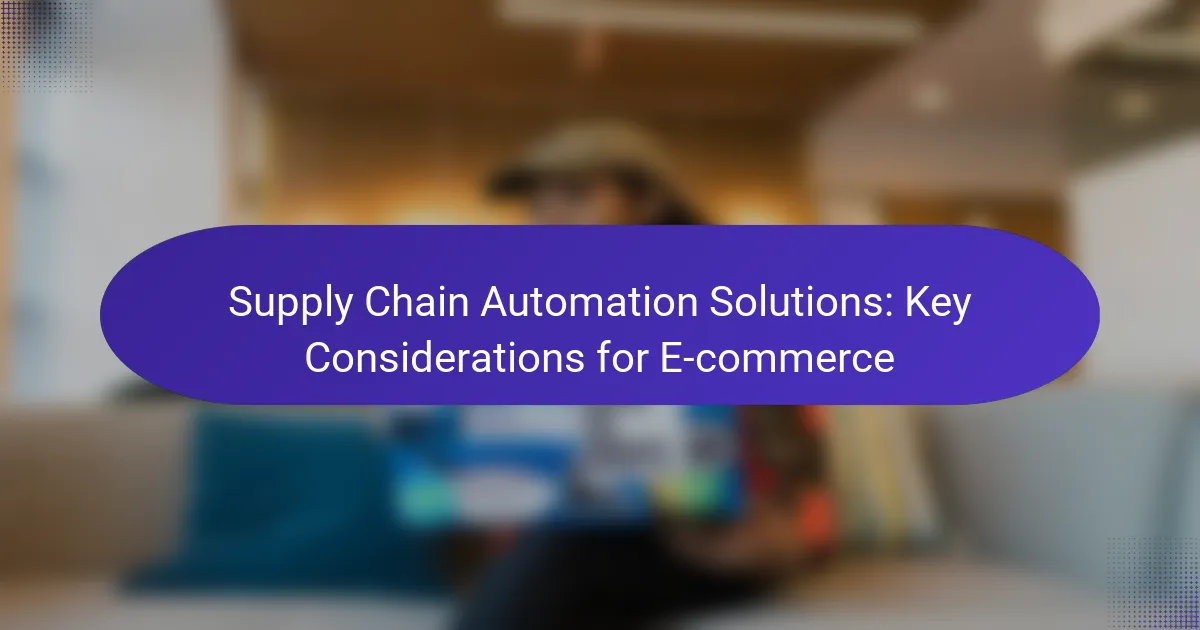In the fast-paced world of e-commerce, supply chain automation solutions are essential for streamlining operations and boosting efficiency. By integrating inventory management, order processing, and logistics, these tools not only enhance workflow but also improve customer satisfaction. When selecting automation solutions, businesses should focus on features like real-time tracking, seamless integration, and scalability to ensure adaptability and growth.

What are the best supply chain automation solutions for e-commerce?
The best supply chain automation solutions for e-commerce streamline operations, enhance efficiency, and improve customer satisfaction. Key options include platforms that integrate inventory management, order processing, and logistics to create a seamless workflow.
Shopify Fulfillment Network
The Shopify Fulfillment Network offers a comprehensive solution for e-commerce businesses looking to automate their supply chain. It provides warehousing, inventory management, and shipping services, allowing merchants to focus on sales while Shopify handles logistics.
Key considerations include the ability to access multiple fulfillment centers across the U.S., which can reduce shipping times and costs. Merchants should evaluate their order volumes to determine if the service aligns with their business needs.
Amazon Supply Chain Automation
Amazon’s supply chain automation tools are designed for sellers on its platform, providing features like Fulfillment by Amazon (FBA). This service allows businesses to store products in Amazon’s warehouses, where they handle storage, packaging, and shipping.
Using FBA can significantly enhance delivery speed and customer service, but sellers must factor in Amazon’s fees, which can impact profit margins. It’s crucial to analyze product pricing and shipping costs to ensure competitiveness.
ShipBob Logistics
ShipBob is a third-party logistics provider that specializes in e-commerce fulfillment. It offers a network of fulfillment centers to help businesses automate shipping and inventory management, ensuring faster delivery to customers.
Businesses should consider ShipBob’s integration capabilities with various e-commerce platforms, which can simplify order processing. Additionally, evaluating the pricing structure is essential to avoid unexpected costs as order volumes fluctuate.
Brightpearl Inventory Management
Brightpearl provides a robust inventory management solution that integrates with various sales channels. It automates inventory tracking, order management, and reporting, enabling businesses to maintain optimal stock levels.
Using Brightpearl can help reduce stockouts and overstock situations, which are common pitfalls in e-commerce. Companies should assess their specific inventory needs and the software’s scalability to ensure it fits their growth plans.
Skubana Order Management
Skubana is an order management platform that centralizes operations for e-commerce businesses. It automates order processing, inventory management, and analytics, allowing merchants to streamline their supply chain activities.
When considering Skubana, businesses should look at its compatibility with existing systems and the learning curve for staff. Effective training and onboarding are crucial to maximizing the platform’s benefits and avoiding disruptions in operations.

How can supply chain automation improve e-commerce efficiency?
Supply chain automation can significantly enhance e-commerce efficiency by streamlining processes, reducing manual errors, and optimizing resource allocation. By implementing automated systems, businesses can achieve faster operations and better overall performance.
Reduced operational costs
Automating supply chain processes can lead to substantial reductions in operational costs. By minimizing manual labor and improving process efficiency, businesses can lower expenses related to staffing, training, and errors. For instance, companies may see cost savings ranging from 10% to 30% after implementing automation technologies.
Additionally, automation can reduce overhead by optimizing inventory management and logistics. This means fewer resources spent on excess stock and improved shipping efficiency, which can further enhance profitability.
Faster order fulfillment
Supply chain automation accelerates order fulfillment by streamlining the picking, packing, and shipping processes. Automated systems can process orders in real-time, significantly reducing the time from order placement to delivery. Many e-commerce businesses can achieve fulfillment times of under 24 hours with effective automation.
Moreover, automation allows for better coordination between warehouses and distribution centers, ensuring that products are dispatched quickly and accurately. This efficiency not only improves customer satisfaction but also enhances repeat business.
Enhanced inventory accuracy
Automated supply chain solutions improve inventory accuracy by utilizing real-time data tracking and management systems. This reduces discrepancies between actual stock levels and recorded inventory, which is crucial for maintaining customer trust and satisfaction. Businesses can achieve inventory accuracy rates of 95% or higher with the right automation tools.
Furthermore, automated inventory systems can alert businesses to low stock levels or overstock situations, enabling proactive management. This helps prevent stockouts and excess inventory, ensuring that e-commerce operations run smoothly and efficiently.

What key features should e-commerce businesses look for in automation tools?
E-commerce businesses should prioritize features that enhance efficiency, visibility, and adaptability in their supply chain automation tools. Key considerations include real-time tracking capabilities, seamless integration with existing platforms, and scalability options to accommodate growth.
Real-time tracking capabilities
Real-time tracking capabilities are essential for e-commerce businesses to monitor inventory levels and shipment statuses instantly. This feature allows companies to provide accurate delivery estimates to customers, reducing uncertainty and enhancing satisfaction.
When evaluating tracking solutions, look for tools that offer GPS tracking, automated alerts, and integration with logistics providers. These functionalities help businesses respond quickly to delays or issues, maintaining a smooth operational flow.
Integration with existing platforms
Automation tools must integrate seamlessly with existing e-commerce platforms, such as Shopify, WooCommerce, or Magento. Effective integration minimizes disruptions and ensures that data flows smoothly between systems, enhancing overall efficiency.
Consider tools that support APIs or pre-built connectors for popular platforms. This compatibility reduces the time and cost associated with implementation and allows for a more cohesive operational ecosystem.
Scalability options
Scalability options are crucial for e-commerce businesses anticipating growth. Automation tools should be able to handle increased order volumes and expanded product lines without significant additional investment or system overhauls.
Look for solutions that offer tiered pricing models or modular features, allowing businesses to pay for only what they need initially and expand as they grow. This flexibility can help manage costs while ensuring that the system can evolve with the business’s demands.

What are the challenges of implementing supply chain automation?
Implementing supply chain automation can present several challenges that businesses must navigate to achieve efficiency. Key obstacles include high initial investment costs, change management issues, and data security concerns.
High initial investment
The upfront costs associated with supply chain automation can be significant. Businesses may need to invest in advanced technology, software solutions, and training for staff, which can range from thousands to millions of dollars depending on the scale of operations.
To mitigate these costs, companies should conduct a thorough cost-benefit analysis and consider phased implementation. This approach allows for gradual investment and can help in assessing the return on investment over time.
Change management issues
Transitioning to automated systems often requires a cultural shift within the organization. Employees may resist changes due to fear of job loss or unfamiliarity with new technologies, which can hinder the implementation process.
Effective communication and training are essential to address these concerns. Involving employees in the transition process and providing ongoing support can facilitate smoother adoption of automation solutions.
Data security concerns
As businesses automate their supply chains, they become more reliant on digital systems, which can expose them to data security risks. Cyber threats can compromise sensitive information, leading to financial losses and reputational damage.
To enhance data security, companies should implement robust cybersecurity measures, such as encryption and regular system audits. Staying compliant with regulations like GDPR or CCPA is also crucial to protect customer data and maintain trust.

What are the prerequisites for successful supply chain automation?
Successful supply chain automation requires a clear understanding of business goals and a strong IT infrastructure. These elements ensure that automation efforts align with organizational objectives and can be effectively supported by technology.
Clear business objectives
Establishing clear business objectives is crucial for effective supply chain automation. Organizations should define specific goals such as reducing lead times, minimizing costs, or improving inventory accuracy. These objectives guide the selection of automation tools and processes.
For example, a company aiming to enhance customer satisfaction might prioritize faster order fulfillment. This focus will shape the automation strategy, ensuring that the chosen solutions directly contribute to achieving that goal.
Robust IT infrastructure
A robust IT infrastructure is essential for supporting supply chain automation. This includes having reliable hardware, software, and network capabilities that can handle increased data flow and system integrations. Companies should assess their current IT setup to identify any gaps that may hinder automation efforts.
Investing in scalable solutions, such as cloud-based platforms, can facilitate smoother operations and future upgrades. Additionally, ensuring compatibility with existing systems can prevent disruptions and enhance overall efficiency in the supply chain.

How do e-commerce companies choose the right automation partner?
E-commerce companies select automation partners by evaluating their technology capabilities, industry experience, and alignment with business goals. Key considerations include scalability, integration with existing systems, and the ability to provide ongoing support.
Assessing Technology Capabilities
When choosing an automation partner, e-commerce businesses should first assess the technology capabilities offered. This includes evaluating the software’s ability to handle inventory management, order processing, and logistics seamlessly. Look for solutions that provide real-time data analytics and reporting features to enhance decision-making.
Consider whether the technology can integrate with existing platforms, such as e-commerce websites and ERP systems. A partner that offers customizable solutions can better meet unique business needs.
Evaluating Industry Experience
Industry experience is crucial when selecting an automation partner. Companies should prioritize partners with a proven track record in the e-commerce sector, as they will better understand the specific challenges and requirements of the industry. Look for case studies or testimonials that demonstrate successful implementations.
Additionally, consider the partner’s experience with similar business models, whether B2B or B2C. This can provide insights into how well they can cater to your specific operational needs.
Alignment with Business Goals
Choosing an automation partner that aligns with your business goals is essential for long-term success. Clearly define your objectives, such as improving order fulfillment speed or reducing operational costs, and ensure the partner can support these aims. Discuss their approach to scalability and adaptability, as your business may grow or pivot in the future.
Establishing a strong communication channel with the partner can facilitate alignment and ensure that both parties are on the same page regarding expectations and deliverables.
Cost Considerations
Cost is a significant factor in selecting an automation partner. E-commerce companies should evaluate the total cost of ownership, which includes initial setup, ongoing maintenance, and potential upgrade costs. Compare pricing models, such as subscription-based versus one-time fees, to find the best fit for your budget.
Be cautious of hidden fees that may arise during implementation or scaling. Request a detailed breakdown of costs and consider negotiating terms to ensure transparency.
Support and Maintenance
Ongoing support and maintenance are critical when partnering with an automation provider. Assess the level of customer support offered, including response times and availability of technical assistance. A partner that provides comprehensive training and resources can help your team maximize the benefits of the automation solution.
Regular updates and maintenance are also important to keep the system running smoothly. Ensure that the partner has a clear plan for updates and how they will communicate changes to your team.



